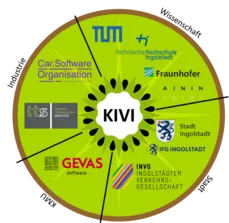KIVI - Artificial Intelligence in the Transportation System in Ingolstadt
Project Description
Despite increasing digitalization and networking, current traffic systems are largely characterized by incomplete information about all road users. As a result, pedestrians and cyclists in particular often cannot be given sufficient consideration in traffic control and traffic safety functions. For motorized road users, too, the individual quality of information increases through constant improvement of sensor equipment and situation analysis capabilities, but the availability of this data for traffic control systems is usually not given. On the part of the public authorities, this reduces the possibilities for global optimization and efficiency increase for all road users and thus leads to unnecessary waiting times.
Project Goal
KIVI addresses this issue and tries to increase efficiency in the areas of traffic control and road safety by increasing the data set of all road users, which is mostly not accessible so far. Through data fusion as well as the use of AI procedures, it is examined how traffic signal systems can be optimized by more comprehensive, up-to-date information about all road users and how traffic safety can be increased especially at intersections as accident hot spots.
Implementation
In KIVI, data-driven AI procedures are developed to improve traffic control and safety. For this purpose, a high definition test field will be established across several intersections, equipped with local sensor technology to detect all road users. This stationary view will be supplemented and AI-based merged with additional mobile sensor technology (cars, buses, bicycles and pedestrians equipped with 5G smartphones) to generate a comprehensive up-to-date digital image of the local and network-wide traffic situation and to be able to make a prognosis of the multimodal network-wide traffic situation. Based on this, a demand-oriented green time distribution for all traffic participants and a traffic light phase assistant will be implemented. A warning function will also be developed that uses AI procedures to recognize the behavior and intentions of (non-)motorized road users and to warn them visually and acoustically of dangerous situations.
Tasks of the Chair
The Chair of Traffic Engineering is responsible for the overall coordination and control of the project. Further focal points of the chair are the development of new AI-based methods for data fusion, analysis and prognosis as well as for the improvement of traffic control both locally and network-wide. In each case, all road users are taken into account. The chair also develops a concept for a drone-based traffic monitoring and analyzes the resulting data to validate the developed methods.
| Keywords | Artificial Intelligence, fusion of mobile and stationary data, traffic control, traffic safety |
| Funding | Federal Minister of Transport and Digital Infrastructure |
| Website | |
| Partners | City of Ingolstadt Technische Hochschule Ingolstadt Artificial Intelligence Network Ingolstadt gGmbH (AININ) Fraunhofer-Institute for Transportation and Infrastructure Systems GEVAS software GmbH Traffic Technology Services Europe GmbH Volkswagen car.SW Org Wolfsburg AG |
| Duration | October 2020 – October 2023 |
| Contact | Lisa Kessler, Martin Margreiter |


